The United Kingdom is confronting an escalating water crisis following its driest spring since 1893. The National Drought Group (NDG) convened on 5 June 2025 to address the pressing challenges posed by this unprecedented climatic event. Reservoir levels have plummeted to 77% capacity, a stark contrast to the typical 93% for this time of year, prompting the declaration of a drought in the northwest and raising concerns across other regions.

Backwater Reservoir and dam in Angus, Scotland in May 2025.
Climate Patterns and Their Consequences
Spring 2025 has been recorded as the hottest and sunniest in UK history, with average temperatures reaching 9.5°C—1.4°C above the seasonal norm—and sunshine hours soaring to 653.3, marking a 43% increase over the average. Rainfall was alarmingly scarce, with England receiving only 128.2mm, 40% below average, making it the driest spring since 1976. These conditions have led to depleted reservoirs and stressed agricultural lands, with farmers reporting poor crop growth and insufficient grass for livestock feed.
Immediate and Long-Term Implications
Agricultural Strain: The agricultural sector is under significant pressure. Parched fields and inadequate rainfall have jeopardised crop yields, placing the upcoming harvest at risk. Livestock farmers are also grappling with feed shortages due to poor grass growth.
Water Supply Challenges: The current reservoir levels are lower than those observed during the 2022 drought. Water companies have activated drought plans, focusing on leak repairs and customer communication. However, without substantial rainfall, further measures, including potential hosepipe bans, may be necessary.
Environmental Concerns: Reduced river flows and groundwater levels threaten aquatic ecosystems. The risk of wildfires has also increased, particularly in moorland areas where dry conditions prevail.
Mitigation Strategies and Future Preparedness
Infrastructure Development: In response to the growing water scarcity, the UK government has approved the construction of two major reservoirs in East Anglia and Lincolnshire—the first in over 30 years. These projects aim to bolster water supplies for over 750,000 homes in water-stressed regions. Additionally, plans are underway for seven more reservoirs by 2050.
Enhanced Monitoring and Regulation: The Environment Agency is intensifying compliance checks on water-intensive industries and increasing the monitoring of river and groundwater levels. Efforts are also being made to assist farmers in planning their water usage effectively.
Public Engagement: Authorities are urging the public to adopt water-saving practices, such as using water butts for garden irrigation and avoiding non-essential water use. Public awareness campaigns are crucial in promoting responsible water consumption.

Garden hose reel sitting unused on a dry lawn. Hosepipe ban in UK due to drought.
The Role of Climate Change
The frequency and intensity of droughts in the UK are exacerbated by climate change. Persistent high-pressure systems have disrupted typical weather patterns, leading to prolonged dry spells. Furthermore, sea temperatures around the UK have risen significantly, contributing to altered climatic conditions.
Building Resilience: Securing the UK’s Water Future
The UK's experience with the driest spring in over a century underscores the urgent need for comprehensive water management strategies. While immediate measures are being implemented to mitigate the current crisis, long-term solutions, including infrastructure development, regulatory enhancements, and public engagement, are essential to build resilience against future droughts. As climate change continues to influence weather patterns, proactive adaptation and sustainable practices will be pivotal in safeguarding the nation's water resources.




